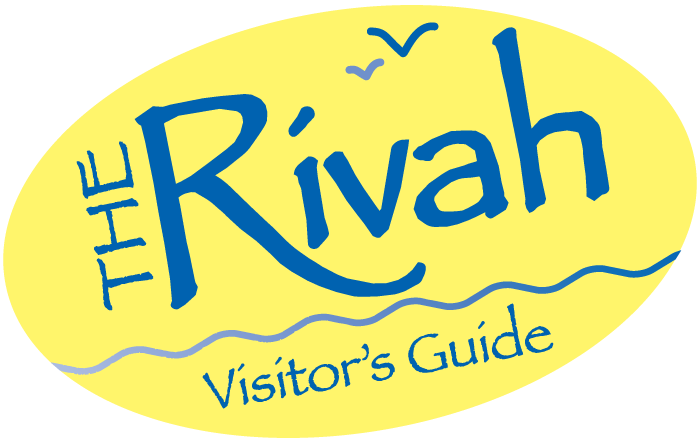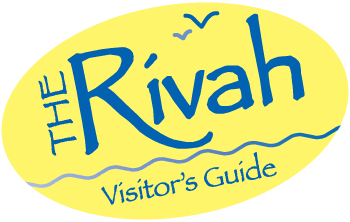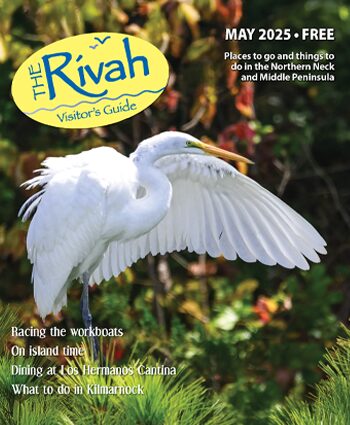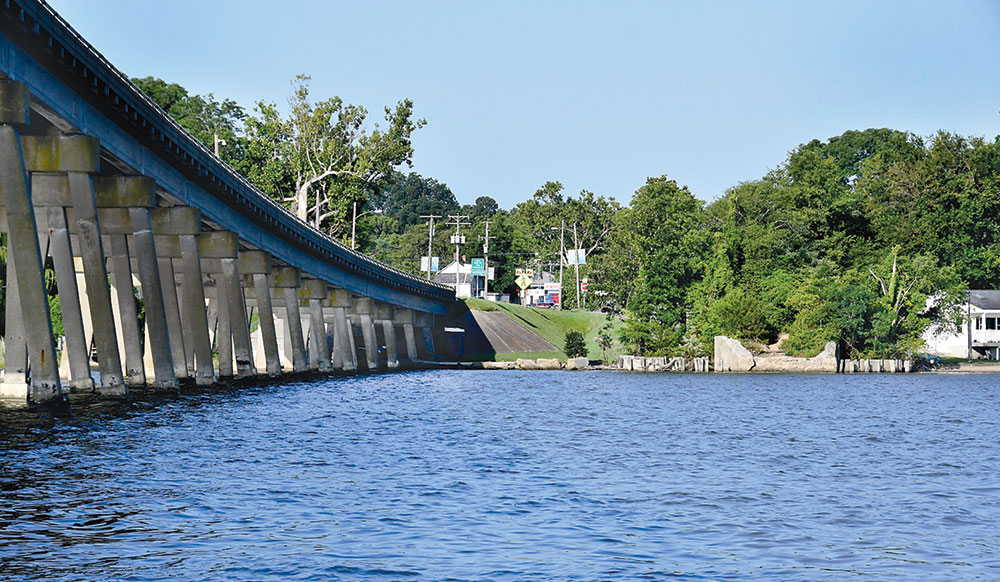 by Tom Chillemi –
by Tom Chillemi –
There are mysteries in the Rappahannock River, known only by a few. Forgotten but not gone are relics, sinking in river mud at Tappahannock. Their stories would be lost except for those who have taken time to learn about the past and bring them forward to the present.
Another type of discovery awaits. Here 33 miles up the Rappahannock from the Chesapeake Bay, fresh water mixes with brackish water in a unusual ecological zone.
Nate Parker and Richard Moncure of Rappahannock Roundstern, a local charter boat business in Tappahannock, are ready to take the curious on a journey of discovery aboard two vintage “round stern” deadrise workboats.
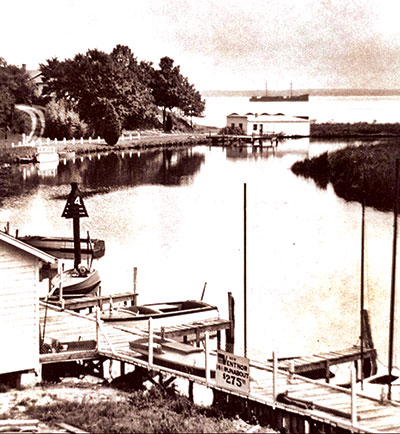
Parker, who traces his ancestors back several generations at Tappahannock, is a historian.
Moncure, a former Friends of the Rappahannock steward, is currently the S.T.R.E.A.M. director at St. Margaret’s School in Tappahannock, combining science curriculums.
Salt Wedge
Moncure explained the Rappahannock River offers a dynamic habitat at the river’s “salt wedge,” where salt and freshwater converge. It’s an ecosystem where bald eagles, blue crabs, oysters and many fish species call home. It’s a place that changes through the year as the earth and water warm, he said. Ospreys spend their summers nesting and raising fledglings before returning to South America for the winter.
The water’s nature mysteries surface here in the form of dolphins that swim through in summer months, said Moncure. These mammals surface to catch a breath, giving observers a short glimpse of their friendly faces that seem to smile.
Fortunately for would-be swimmers there are almost no jellyfish due to the fresh water’s influence.
The area is an amazing fishery that includes many native species like perch, croaker and striped bass, said Moncure. “But you can also cruise into a local creek a few turns and catch a largemouth bass or a long nose gar,” he explained. “This part of the river is also the home to a few non-native fish like blue catfish and snakeheads, which are also fun to catch and eat for dinner as well.”
Sturgeon are seen, but only very rarely, adding to the river’s mystique. “They’re hiding on the bottom,” Moncure added.
The Rappahannock River at Tappahannock is also a place where the landscape makes it easy to imagine Captain John Smith’s journey up the river more than 400 years ago where he met the Rappahannock Tribe.
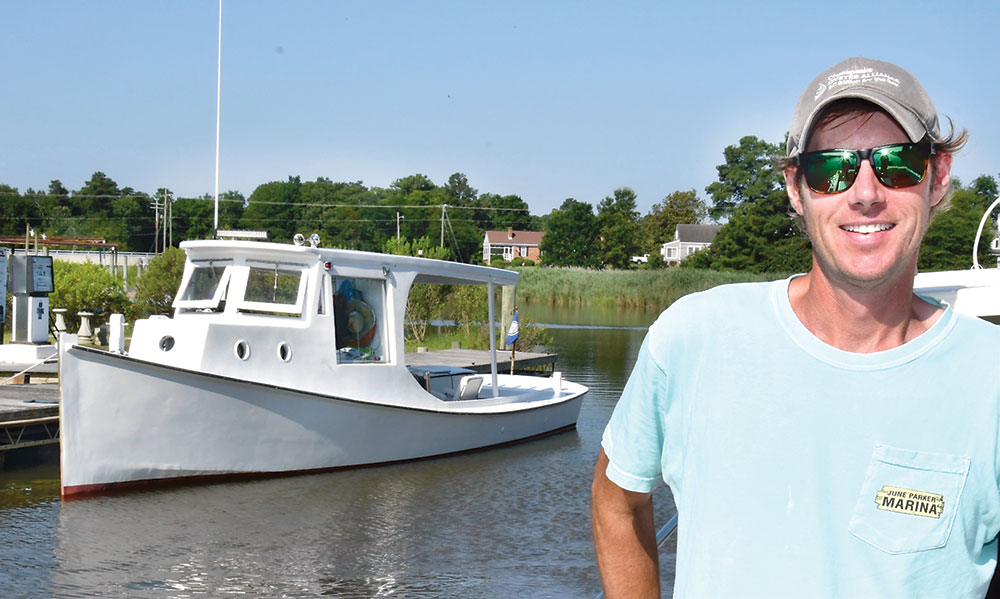
History is all around Tappahannock
Nate Parker of Rappahannock Roundstern enjoys talking about history in a way that brings back the past.
Parker and Richard Moncure operate Rappahannock Roundstern, which owns two antique wooden hand-built roundstern deadrises built on the Rappahannock for watermen.
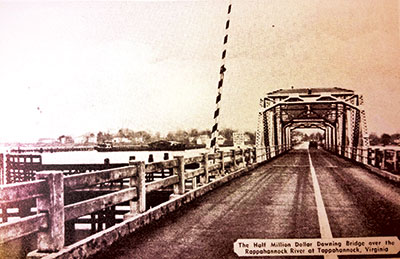
These style boats were once used by many watermen for oystering, crabbing and many types of fishing on the Chesapeake Bay and its tributaries, unfortunately since the invention of fiberglass vessels these wooden deadrise boats have become a “dying breed,” said Parker.
Rappahannock Roundstern specializes in historic cruises, scenic tours, bird watching, eco-tours as well as fishing. Moncure is the former Friends of the Rappahannock steward and is currently the S.T.R.E.A.M. director at St. Margaret’s School. Parker manages June Parker Marina, where Rappahannock Roundstern is based. He also serves on the Essex County Wetlands Board and has volunteered his marina’s beach for many years to the Virginia Institute of Marine Science (VIMS) to do river sampling.
Parker and Moncure both care very much about the Rappahannock and its history, marine science, and ecology and they enjoy teaching how and why to care for the river. And, giving folks an opportunity to enjoy the Rappahannock and all it has to offer.
To book a history and science cruise,
call Parker at 313-0099
or Moncure at 214-0447.
Roots
Parker has Rappahannock River water in his veins. He traces his ancestors back several generations.
Pilings mark the place where a thriving pier once offloaded goods from steamboats.
Before the pier was built, ships from England moored here and loaded goods bound for Europe.
Tappahannock’s ghost ship
“Caponka” was a large wooden cargo ship that was constructed for the United States Shipping Board in 1918 by Grant Smith-Porter Co. located in Portland, Ore. Quite a few similar vessels were built due to a shortage of cargo ships needed during World War I. She was a quick vessel and her first and only voyage was to the Philippines, the Far East and the Mediterranean.
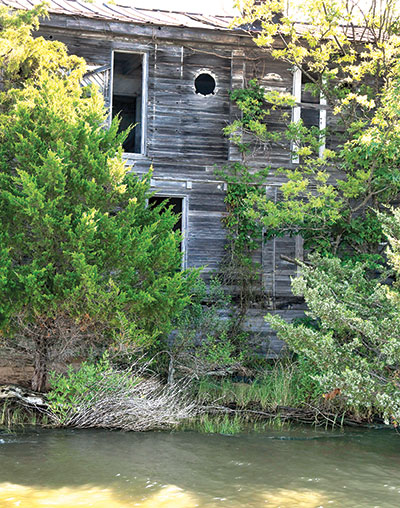
After WWI many of these cargo ships were not needed anymore. In 1920 “Caponka” was sent to the Potomac to join the ghost ship fleet. In 1924 she was bought by Capt. Plummard Derieux and headed to Tappahannock to be used for grain storage near the steamboat wharf. During a bad storm in the 1930s she broke free and floated onto the mud flat where her remnants remain, said Parker.
Part of the ship’s pilothouse was dismantled and the lumber was used to build Zac Johnson’s ferry boathouse that remains on the north shore of the Rappahannock across from Tappahannock.
Many stories have been told about what “Caponka” was used for after getting stuck, explained Parker. In 1949 the ship caught fire and burned to the waterline.
Numerous stories have been told about how the fire began. The derelict ship had become a place where men congregated to “relax” and play poker. Many believe a fight broke out one night when an oil lantern was broken and the fire began.
What’s left of the hull is not visible even at low tide. Many boaters have hit the ghost ship lurking just below the water’s surface. The shipwreck is now marked on most marine charts.
From ferry to bridge
Before the construction of bridges across the Rappahannock River at Tappahannock the only way to get across was by ferry boats, explained Parker.
Zac Johnson of the Northern Neck built a ferry house out of the “Caponka” pilothouse. Flags were used to signal. If someone in Tappahannock wanted to cross, they would raise a red flag. Johnson would signal his reply. If it were a black flag, that meant he was not operating.

Johnson ferried cars and trucks across the Rappahannock until the first of two bridges was constructed in 1927. The low bridge had a swing span that opened to allow boats to pass.
The bridge was named for State Senator Colonel Thomas J. Downing. His 7-year-old grandson, also named Thomas Downing, cut the ribbon with an oyster knife on the day the bridge was opened.
Young Thomas Downing followed in his grandfather’s footsteps and became a politician who served numerous terms on Virginia’s Senate.
The current Downing Bridge was constructed in 1967. It was a much higher bridge, which meant boats could pass under it. Thomas Downing was at the dedication ceremony for the current bridge as well, said Parker.
After the new bridge was built the original bridge was deconstructed and scrapped. The majority of the concrete piles used in the building of the first bridge were bought by the man who was attempting to build Tappahannock Marina, now June Parker Marina, and were used for construction and fill.
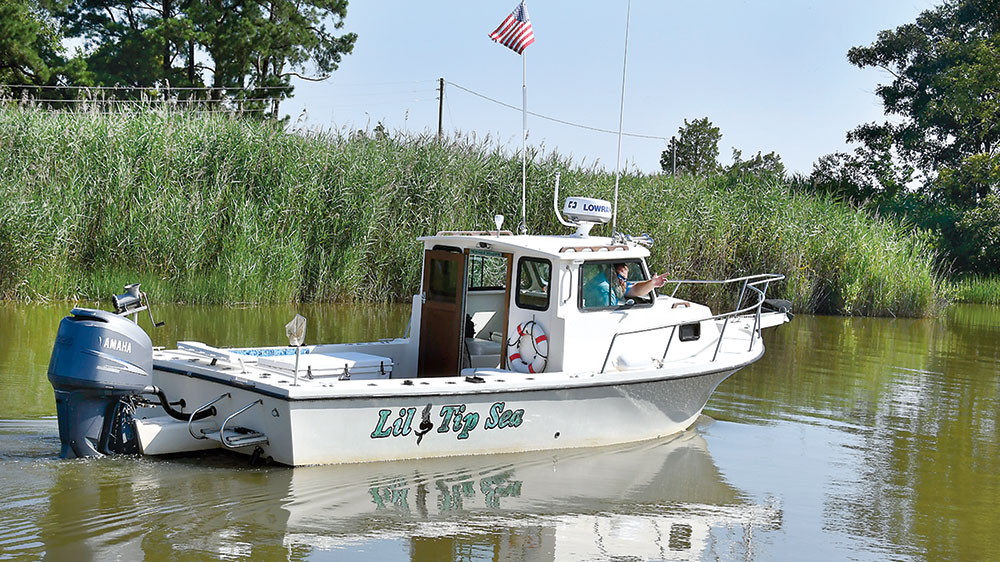
Discover The Rappahannock River
with a Capt. Bull custom cruise
Boat owners have a saying, “A boat is a hole in the water that you dump money into.” Few can argue that. But, there is an alternative to owning a boat — Tip Sea Charters based in Lancaster County at Windmill Point Marina, and in Tappahannock at June Parker Marina.
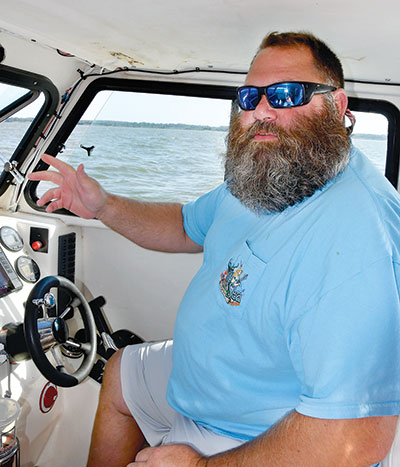
Dan Kurdziel “Captain Bull” is a U.S. Coast Guard-licensed charter boat captain. His boat can zip to a fishing spot, idle for sightseeing and looking for dolphins, or just float so clients can take in a sunset. In fact, Capt. Bull encourages clients to customize their cruise. “If you can think of a cruise, I’m on board,” he said. “I’m the Northern Neck’s do-all charter service.”
Capt. Bull, 42, brings decades of experience to the helm of his 25-foot long Parker boat, which is approved to carry six passengers. He’s been boating the Rappahannock River for 24 years. He got his first boat when he was a teen, so he knows the waters well.
Cruises
Cruises start at $300 and Capt. Bull said he’s flexible when it comes to rough weather and knows when to stay in port. “I want everyone to be comfortable and have a good time,” he said.
For those living on the waterfront or staying at a waterfront short-term rental, Tip Sea Charters will pick clients up at their dock. They can bring their own refreshments. “Think of me as your buddy going out on the water.”
His boat “Lil Tip Sea” has been outfitted with non-slip floors, cushioned deck chairs and fishing rods. No fishing license is needed, since the boat has a license that covers occupants, and Capt. Bull brings the bait. He offers full and half day fishing charters.
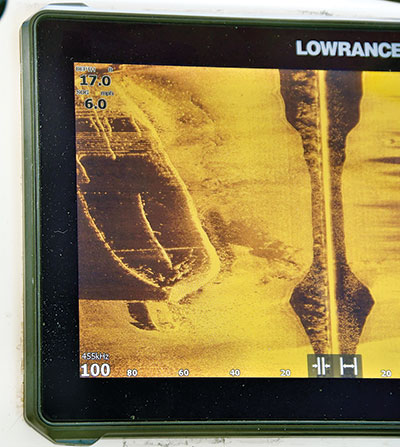
Going on a charter is a way to see if you like boating and get a feel for what it’s like, said Capt. Bull, who added the cost of a charter is oftentimes less than the boat maintenance costs. Chartering a boat takes away some of the responsibilities of owning a boat.
Capt. Bull enjoys history and gives water history tours at Tappahannock. His boat is outfitted with side-scan radar that can see underwater and produces a vivid image of a sunken ship in the Rappahannock River near the Downing Bridge. “Caponka” was built as a 200-foot long cargo ship during World War I and ended up as a grain storage boat in Tappahannock before breaking free from this mooring and going aground in the 1930s.
It burned to the waterline in 1949.
Tip Sea Charters also gives tours to Fones Cliffs on the Rappahannock River, a habitat for bald eagles.
For information, call Capt. Bull at 761-0975.
Smith gave river, village Native American names
In 1608 Captain John Smith sailed up the Rappahannock River, 33 miles from Chesapeake Bay, where he found a Native American village. According to the Town of Tappahannock website, Capt. Smith gave the river and the village Native American names.
Rappahannock, means “rise and fall” of water. The village became Tappahannock, which means “town on the rise and fall of water.”
About 50 years later in the early 1660s, ship’s captain Richard Hobbs patented 800 acres at Tappahannock and the area became known as “Hobbs His Hole.” The term “hole” refers to deep water and a good anchorage.
In 1680 the English Crown decreed that there were to be 20 towns established that would be official ports so that all trade, both import and export, could be monitored by the agents of the English. By act of the Virginia General Assembly, Tappahannock was established as a port town, so was Urbanna.
